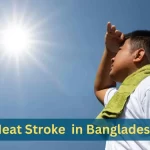As temperatures continue to rise in Bangladesh, the threat of heat-related illnesses, especially heat stroke, becomes more pressing. Heat stroke is a severe condition that can cause significant harm and even be fatal if not promptly addressed. This guide aims to raise awareness and provide essential information on how to prevent and respond to heat stroke, ensuring the well-being of everyone in Bangladesh.
This rule is composed to extend and give vital data on how to avoid and react to heat stroke among the individuals living in Bangladesh.
Table of Contents
What is Heat Stroke?

Heat stroke occurs when your body overheats and is unable to cool down effectively, typically as a result of prolonged exposure to or physical exertion in high temperatures. This most severe form of heat-related illness necessitates emergency treatment. Unlike heat exhaustion, which is less severe and can be managed with rest and hydration, heat stroke can cause damage to the brain and other internal organs if not treated immediately.
Causes and Risk Factors
In Bangladesh, the combination of high temperatures and high humidity creates an environment where heat stroke is a significant risk. Certain groups are more susceptible, including outdoor workers, the elderly, children, and those with pre-existing health conditions. Understanding these risks is crucial for prevention.
Symptoms of Heat Stroke
Recognizing the signs of 𝐡𝐞𝐚𝐭 𝐬𝐭𝐫𝐨𝐤𝐞 can save lives. Symptoms include:
- High body temperature (above 104°F or 40°C)
- Altered mental state or behavior
- Alteration in sweating
- Nausea and vomiting
- Flushed skin
- Rapid breathing
- Racing heart rate
If you or someone else exhibits these symptoms, it’s critical to seek immediate medical help.
Preventive Measures
Preventing 𝐡𝐞𝐚𝐭 𝐬𝐭𝐫𝐨𝐤𝐞 involves simple yet effective strategies:
- Stay hydrated: Drink plenty of water, and avoid alcohol and caffeine as they can lead to dehydration.
- Wear loose, lightweight, light-colored clothing to reflect heat.
- Use a hat and sunglasses to protect against the sun.
- Limit exposure to the sun during midday, typically between 10 a.m. and 4 p.m.
- Use air conditioning or spend time in shaded or cool places.
The role of the community and local government is also pivotal in providing safe havens during heat waves, such as air-conditioned public spaces and adequate hydration stations.
First Aid and Emergency Response
Immediate action can significantly reduce the severity of 𝐡𝐞𝐚𝐭 𝐬𝐭𝐫𝐨𝐤𝐞:
- Summon Medical Aid Immediately: Time is crucial, so immediate medical help is necessary.
- Move to a Cooler Place: Relocate the affected person to a shady or air-conditioned environment.
- Cool Down: Use cool water, wet towels, or even a bath to help reduce the person’s body temperature.
- Avoid Giving Liquids if Unconscious: To prevent choking, do not give drinks if the person is not fully conscious.
Long-Term Strategies and Solutions
Efforts to combat heat stroke in Bangladesh require enduring commitment and actions:
- Urban Planning: Incorporate more green spaces to mitigate urban heat.
- Public Health Campaigns: Launch campaigns to raise awareness of the risks associated with heat waves.
- Education: Establish educational programs that highlight how to recognize heat stroke symptoms and respond with appropriate first aid.
Personal Stories and Case Studies
For occurrence, a farmer from a rural area in Bangladesh might describe his battle with heat stroke amid the gathering season and talk about the preventive measures he has since actualized. These personal accounts can make the issue more relatable with timely intervention .
This approach not only educates the community but too personalizes the potential threats, making the requirement for preventive measures and speedy response more pressing.
FAQs
1.What is the quickest way to treat heat stroke?
Immediate cooling by any means necessary is crucial for treating heat stroke.
2.How much water should I drink to prevent heat stroke?
It’s recommended to drink at least 8-10 glasses of water a day, and more if you are active outdoors.
3.Can heat stroke happen when kids are bundled up as well?
Yes. Children can get overheated on the off chance that they are over bundled. Since the most youthful children cannot uncover themselves, it’s imperative to pay consideration and offer assistance to them.
Final Contemplations
H𝐞𝐚𝐭 𝐬𝐭𝐫𝐨𝐤𝐞 postures an extreme threat in Bangladesh due to its tropical climate and tall stickiness. Recognizing the signs and knowing how to reply can be life-saving. Heat stroke poses an extreme threat in Bangladesh due to its tropical climate and tall stickiness. Recognizing the signs and knowing how to reply can be life-saving. It is fundamental for all people and communities to work in perilous conditions.
Let’s Talk
Let’s all do our portion in spreading the word approximately the perils of 𝐡𝐞𝐚𝐭 𝐬𝐭𝐫𝐨𝐤𝐞 and how to avoid it. This guideline: Share with friends and family, and stay informed about the best practices for staying safe during heat waves. Protect our communities from the risks of heat stroke.





